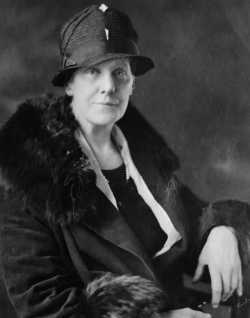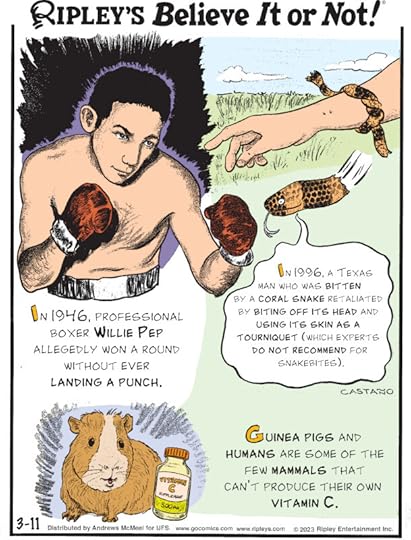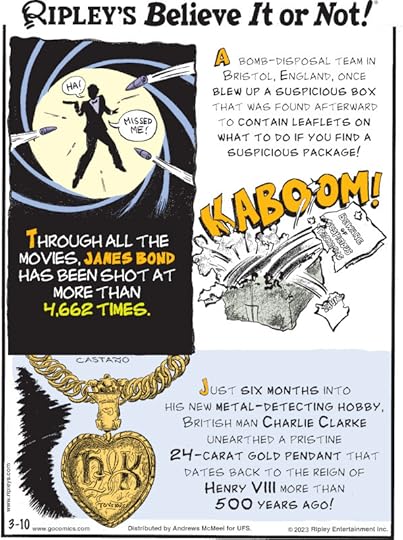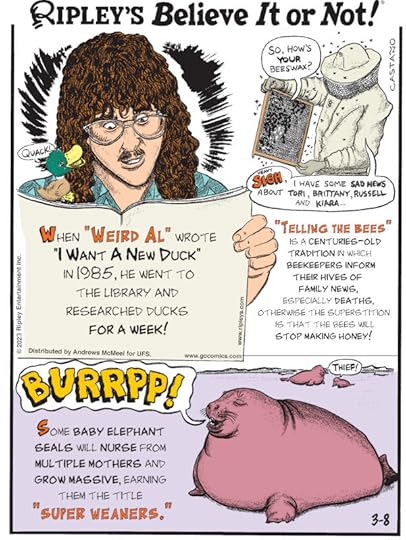Ripley Entertainment Inc.'s Blog, page 38
March 12, 2023
CARTOON 03-12-2023
March 11, 2023
CARTOON 03-11-2023
March 10, 2023
The Truth Behind William Howard Taft’s Tub
Featured in Ripley's Believe It or Not!

Rumors abound that the 27th president of the United States, William Howard Taft, got stuck in a bathtub at the White House due to his portly size. Specifically, most stories say he was only removed once six people helped pry his flabby, naked body out, and some looser interpretations even suggest he died from the ordeal.
Welcome to Ripley’s History Off the Record, the show that explores the parts of history your textbooks never talked about. Today, we’re investigating a president who often gets little coverage, filling in the gap between founding father presidents and FDR. Sure, there’s another Roosevelt in there that gets attention, but by and large presidents Hayes through Hoover aren’t that well known. Even I could tell you precious little interesting things about President Chester Alan Arthur, but—in my very humble opinion—Taft at least deserves a little more than a body-shaming anecdote.
Taft’s StrugglesWhile it is true that Taft was America’s heaviest president, the story of him getting stuck in the tub itself has less evidence. I’m here to tell you why this story is not only untrue but how the whole story might just be a smear campaign orchestrated by conspiring toilet manufacturers.

William Howard Taft. Via Wikimedia Commons.
A wrestler and dancer in his younger years, Taft stood six feet tall and weighed in at 340 pounds by the end of his presidency. Despite his size, Taft was always commended for his gentle spirit. He was said by many to be the politest man in Washington, and himself admitted that he was much too quiet for the politics of his office. In the same way that George Washington struggled to manage his teeth, Taft struggled to manage his weight for most of his life, participating in a litany of fad diets and weight loss programs throughout his life.
To look into this rumor, I scoured and cross-referenced every single surviving historical mention of tubs, showers, toilets, baths, and even pools with President Taft, and there are only three events that even come close to the story recounted by hip history buffs, Snapple caps, and children’s books.
The Tub TalesThe first, and most well-documented case is that of Taft ordering a special extra-large tub installed aboard the ship he used while overseeing the construction of the Panama Canal. Pictures of this custom tub can be found with four full-grown adults sitting comfortably inside. The tub was later installed at his request in the White House when he took office.
4 workers fit comfortably in President Taft’s new tub. It was 7 feet long, 41 inches wide & weighed a ton. pic.twitter.com/ctXR2R1GJ8
— Presidential Trivia (@triviapotus) July 19, 2015
An engineering interviewer at the time specifically asked Taft about how he fit in tubs—which the statesman admitted enjoying the casual soak-in—when he traveled, and he simply responded that if no reasonable tub was available, he simply showered. Now, this already pokes a major hole in the stuck story. We know, before he ever stepped foot in the White House, an enormous tub, specifically built for him was installed.
The second mention of Taft and baths was much simpler and involved him spilling water out of a bath in his second-story hotel room which subsequently leaked to the floor below. Embarrassing maybe, but no record of needing six men to unstick him.
The next primary account is where our libelous story starts, however. White House butler, Irwin Hoover, simply wrote that Taft would sometimes “stick” in the tub, and would have “help” getting out. No details about six people or being embarrassingly stuck are made, however.
Lillian Parks, a daughter of a White House maid, gave a second-hand account in a memoir and this account is much less favorable and closer to the widely spread rumors of bath time peril for Taft. This account is full of even more holes though. For one, the elder Parks—the one who worked as a maid in the White House—didn’t begin her career until ten years after Taft left office.
A Bold-Faced Bathroom Lie?While there are no other events we found in papers or periodicals that mention Taft and tubs in a literal sense, something more sinister did arise in our research. The fact that Taft fought the porcelain trust. This cartel of price-fixers conspired to create a monopoly on toilets and bathroom fixtures using patent licenses to control commode costs.
In 1912, the Taft administration successfully blocked this abuse of patent law and broke up the trust. 1912 was also the year Taft fought a bitter election against both Woodrow Wilson, and former friends and President Theodore Roosevelt at the head of the Bull-Moose Party. Campaigns took shots at Taft’s weight, and it’s very likely the bathtub fallacy took hold in the American consciousness at this time. Whether it was partisan gossip, an exaggerated maid’s tale, or the conspiracy of the bath trust seems impossible to know now.
Beyond Taft’s Tub LegacySadly, his weight and the bathtub story are the two biggest footnotes to Taft’s legacy in textbooks and lectures. And since he was treated so unfairly, let me list now some of the cooler things about Taft:
In his political career, he brought forward 80 antitrust lawsuits, reorganized the State Department, presided over the establishment of the income tax, and became the only president to also serve as the Chief Justice of the Supreme Court! Culturally, his campaign made its own attempt at the success of the Teddy Bear, called the Billy Opossum, and brought his very own cow to the White House named Pauline Wayne, who walked the White House lawn and provided the first family and tourists with presidential milk.

Taft as Chief Justice of the Supreme Court. Via Wikimedia Commons.
Though history remembers him as its chubby president—milk non-withstanding, Taft himself claimed his time as a Supreme Court justice was his most fulfilling.
That’s it for today, let us know in the comments if you’ve ever heard the bathtub myth and stay tuned for the next History Off the Record.
EXPLORE THE ODD IN PERSON! Discover hundreds of strange and unusual artifacts and get hands-on with unbelievable interactives when you visit a Ripley’s Odditorium!The Bathtub That Killed A President(‘s Reputation)
Featured in Ripley's Believe It or Not!

Rumors abound that the 27th president of the United States, William Howard Taft, got stuck in a bathtub at the White House due to his portly size. Specifically, most stories say he was only removed once six people helped pry his flabby, naked body out, and some looser interpretations even suggest he died from the ordeal.
Welcome to Ripley’s History Off the Record, the show that explores the parts of history your textbooks never talked about. Today, we’re investigating a president who often gets little coverage, filling in the gap between founding father presidents and FDR. Sure, there’s another Roosevelt in there that gets attention, but by and large presidents Hayes through Hoover aren’t that well known. Even I could tell you precious little interesting things about President Chester Alan Arthur, but—in my very humble opinion—Taft at least deserves a little more than a body-shaming anecdote.
Taft’s StrugglesWhile it is true that Taft was America’s heaviest president, the story of him getting stuck in the tub itself has less evidence. I’m here to tell you why this story is not only untrue but how the whole story might just be a smear campaign orchestrated by conspiring toilet manufacturers.

William Howard Taft. Via Wikimedia Commons.
A wrestler and dancer in his younger years, Taft stood six feet tall and weighed in at 340 pounds by the end of his presidency. Despite his size, Taft was always commended for his gentle spirit. He was said by many to be the politest man in Washington, and himself admitted that he was much too quiet for the politics of his office. In the same way that George Washington struggled to manage his teeth, Taft struggled to manage his weight for most of his life, participating in a litany of fad diets and weight loss programs throughout his life.
To look into this rumor, I scoured and cross-referenced every single surviving historical mention of tubs, showers, toilets, baths, and even pools with President Taft, and there are only three events that even come close to the story recounted by hip history buffs, Snapple caps, and children’s books.
The Tub TalesThe first, and most well-documented case is that of Taft ordering a special extra-large tub installed aboard the ship he used while overseeing the construction of the Panama Canal. Pictures of this custom tub can be found with four full-grown adults sitting comfortably inside. The tub was later installed at his request in the White House when he took office.
4 workers fit comfortably in President Taft’s new tub. It was 7 feet long, 41 inches wide & weighed a ton. pic.twitter.com/ctXR2R1GJ8
— Presidential Trivia (@triviapotus) July 19, 2015
An engineering interviewer at the time specifically asked Taft about how he fit in tubs—which the statesman admitted enjoying the casual soak-in—when he traveled, and he simply responded that if no reasonable tub was available, he simply showered. Now, this already pokes a major hole in the stuck story. We know, before he ever stepped foot in the White House, an enormous tub, specifically built for him was installed.
The second mention of Taft and baths was much simpler and involved him spilling water out of a bath in his second-story hotel room which subsequently leaked to the floor below. Embarrassing maybe, but no record of needing six men to unstick him.
The next primary account is where our libelous story starts, however. White House butler, Irwin Hoover, simply wrote that Taft would sometimes “stick” in the tub, and would have “help” getting out. No details about six people or being embarrassingly stuck are made, however.
Lillian Parks, a daughter of a White House maid, gave a second-hand account in a memoir and this account is much less favorable and closer to the widely spread rumors of bath time peril for Taft. This account is full of even more holes though. For one, the elder Parks—the one who worked as a maid in the White House—didn’t begin her career until ten years after Taft left office.
A Bold-Faced Bathroom Lie?While there are no other events we found in papers or periodicals that mention Taft and tubs in a literal sense, something more sinister did arise in our research. The fact that Taft fought the porcelain trust. This cartel of price-fixers conspired to create a monopoly on toilets and bathroom fixtures using patent licenses to control commode costs.
In 1912, the Taft administration successfully blocked this abuse of patent law and broke up the trust. 1912 was also the year Taft fought a bitter election against both Woodrow Wilson, and former friends and President Theodore Roosevelt at the head of the Bull-Moose Party. Campaigns took shots at Taft’s weight, and it’s very likely the bathtub fallacy took hold in the American consciousness at this time. Whether it was partisan gossip, an exaggerated maid’s tale, or the conspiracy of the bath trust seems impossible to know now.
Beyond Taft’s Tub LegacySadly, his weight and the bathtub story are the two biggest footnotes to Taft’s legacy in textbooks and lectures. And since he was treated so unfairly, let me list now some of the cooler things about Taft:
In his political career, he brought forward 80 antitrust lawsuits, reorganized the State Department, presided over the establishment of the income tax, and became the only president to also serve as the Chief Justice of the Supreme Court! Culturally, his campaign made its own attempt at the success of the Teddy Bear, called the Billy Opossum, and brought his very own cow to the White House named Pauline Wayne, who walked the White House lawn and provided the first family and tourists with presidential milk.

Taft as Chief Justice of the Supreme Court. Via Wikimedia Commons.
Though history remembers him as its chubby president—milk non-withstanding, Taft himself claimed his time as a Supreme Court justice was his most fulfilling.
That’s it for today, let us know in the comments if you’ve ever heard the bathtub myth and stay tuned for the next History Off the Record.
EXPLORE THE ODD IN PERSON! Discover hundreds of strange and unusual artifacts and get hands-on with unbelievable interactives when you visit a Ripley’s Odditorium!Elementary Students Discover Alarming News About Space And EpiPens
Featured in Ripley's Believe It or Not!

Students from St. Brother André Elementary School’s Program for Gifted Learners (PGL) recently teamed up with the University of Ottawa to examine whether EpiPens, the emergency medication used for treating serious allergic reactions, work in space. Believe It or Not!, the students learned that the critical medicine can become poisonous when exposed to conditions on a rocket and high-altitude balloon—something NASA didn’t even know!
A Major DiscoveryThe budding scientists, ages 9 to 12, collaborated with the university to test a theory, specifically how cosmic radiation effects the molecular structure of epinephrine, according to UOttawa. The stars and the sun release high-energy particles that cause cosmic radiation. Earth’s atmosphere does a good job of protecting the planet from this radiation; however, it can be dangerous if astronauts are exposed to cosmic rays for a long period of time. Cosmic radiation can cause issues such as radiation sickness, cancer, and other diseases.
The PGL and UOttawa experiment was part of the Cubes in Space STEM program that allows student research to take place onboard two suborbital flights organized by NASA. When the team’s samples sent into space were returned to UOttawa and the elementary students, the university analyzed it through its John Holmes Mass Spectrometry Core Facility. The epinephrine came back only 87-percent pure. The remaining 13 percent turned into benzoic acid derivatives, making it poisonous.
Full Professor Paul Mayer of UOttawa’s Faculty of Science’s Department of Chemistry and Bimolecular Sciences, explained that his team analyzed the pure epinephrine and the solution from an EpiPen before and after it flew on a rocket and high-altitude balloon. “The ‘after’ samples showed signs that the epinephrine reacted and decomposed,” he noted, adding, “In fact, no epinephrine was found in the ‘after’ EpiPen solution samples. This result raises questions about the efficacy of an EpiPen for outer space applications and these questions are now starting to be addressed by the kids in the PGL program.”
Listen To The KidsThis experiment by the university team and junior scholars from PGL informed researchers about the effects of cosmic radiation on epinephrine and its ramifications when it comes to space travel and astronaut health.
Meanwhile, the work of the PGL students is still ongoing. They are now collaborating on designing a container to safeguard the EpiPen solution in space so it does not transform into a poisonous, unstable substance.
Mayer believes parents and adults should encourage children to seek answers to puzzles and problems they encounter: “Kids are natural scientists. They are curious and ask questions. We adults just need to facilitate their participation in the scientific process, and then get out of the way and let them explore and learn.”
By Noelle Talmon, contributor for Ripleys.com
EXPLORE THE ODD IN PERSON! Discover hundreds of strange and unusual artifacts and get hands-on with unbelievable interactives when you visit a Ripley’s Odditorium!Source: Elementary Students Discover Alarming News About Space And EpiPens
CARTOON 03-10-2023
March 9, 2023
Mother’s Day Founder Anna Jarvis Fought To Have The Holiday Abolished
Featured in Ripley's Believe It or Not!

The founder of Mother’s Day, the force who spearheaded the holiday to honor the hard work of women across the nation, eventually wanted to shut down the very movement she created because it turned into a commercial business.
Uniting WomenJarvis’ mother, Ann Reeves Jarvis, had 13 children, only four of whom reached adulthood. She was involved in organizing Mothers’ Day Work Clubs and a Mothers’ Friendship Day following the Civil War to unite women after so much discord in the country. She died on the second Sunday in May in 1905 and her daughter, Anna, was devastated by the loss.
To honor the woman who gave birth to her and raised her, Anna kicked off the first Mother’s Day events in May 1908. One was held in Grafton, West Virginia, her hometown, and the other at Wanamaker’s department store in Philadelphia, Penn., where she lived.

Credit: NMGiovannucci Via Wikimedia Commons (CC BY-SA 4.0).
Jarvis wanted to make the commemoration an official national holiday, so she sent her suggestion to politicians and newspapers. She was passionate about her cause even though she never had children of her own. In 1910, the governor of West Virginia made it an official holiday. Two years later, a variety of churches, towns, and states had also adopted the holiday, and Jarvis put together the Mother’s Day International Association. President Woodrow Wilson made Mother’s Day a permanent holiday in 1914, designating the second Sunday in May as the official date.
A Misunderstood MovementUnfortunately, Jarvis’ vision for Mother’s Day and how other people interpreted the holiday was very different. “She wanted Mother’s Day to be a very private acknowledgment of all the mother does for the family,” Katharine Antolini, a history professor at West Virginia Wesleyan College told. “It was very sweet.” It’s worth noting the punctuation in the holiday: it’s a singular possessive, not plural, so the intent was for families to honor a single matriarch—not all the mothers a person knows in their life.
Before long, Jarvis made some observations she found unsettling, such as florists, card companies, and candy manufacturers profiting off of the holiday. Public interest groups also used Mother’s Day to promote political statements. This appropriation did not sit well with Jarvis. By 1922, she supported boycotts of florists that increased the prices of white carnations each May (the flower was Ann Jarvis’ favorite). The following year, Jarvis threatened legal action against the New York Mother’s Day Committee for planning a huge celebration. Organizers ultimately canceled the event. In 1925, Jarvis faced charges of disorderly conduct, which were later dismissed, after the American War Mother’s used a white carnation for its Mother’s Day celebration against Jarvis’ wishes.

Anna Jarvis via Wikimedia Commons.
In her opinion, Mother’s Day was a time for children to visit their moms or write them long letters. She called pre-printed cards and ready-made telegrams “maudlin” and “insincere” and a lazy way to commemorate “a woman who has done more for you than anyone else in the world.”
Fighting BackJarvis’ discontent continued over the next decade. In 1935, she criticized First Lady Eleanor Roosevelt for combining Mother’s Day with a fundraising effort involving high maternal and infant mortality rates. Jarvis later created a petition to rescind the holiday and went door-to-door around Philadelphia for support.
Jarvis became increasingly reclusive during the 1940s and was reportedly regretful that she started Mother’s Day in the first place. In 1944 at the age of 80, she was placed in a mental asylum. She died four years later completely broke due to the debt she incurred involving legal battles over the holiday.
While Jarvis never profited over the holiday, it’s big business for retailers. People spend over $23 billion a year to celebrate their moms every May, according to the National Retail Foundation. They purchase everything from cards, flowers, candy, clothing, and jewelry to smartphones and other tech devices.
And, in case you’re wondering, Father’s Day was first celebrated in 1910, but it didn’t become a nationwide holiday until 1972. It’s celebrated on the third Sunday of June. Children reportedly spend $14.3 billion on their fathers, which is significantly less than what they spend on their mothers.
By Noelle Talmon, contributor for Ripleys.com
EXPLORE THE ODD IN PERSON! Discover hundreds of strange and unusual artifacts and get hands-on with unbelievable interactives when you visit a Ripley’s Odditorium!Source: Mother’s Day Founder Anna Jarvis Fought To Have The Holiday Abolished
CARTOON 03-09-2023
March 8, 2023
The Canary Resuscitator Machine Miners Once Used
Featured in Ripley's Believe It or Not!

Mining has always been a risky profession, but in the early 20th century, it was even more dangerous. A report published by the Centers for Disease Control and Prevention (CDC) shows that “the period 1900 through 1909 was the deadliest decade in U.S. underground coal mining,” with 3,660 miners dying in over 100 incidents around the country. In comparison, “only” 7,946 miners died between 1910 and 2006.
Canary ConnectionPart of the reason for that lower number was the introduction of canaries in coal mines in 1911. The idea of using canaries in mines comes from British physician John Scott Haldane, whose research into gases and their effects on people earned him the nickname of “the father of oxygen therapy.” Haldane invented one of the earliest gas masks and researched decompression sickness, but one of his main interests was understanding what caused so many mining disasters.

John Scott Haldane. Via Wikimedia Commons.
His suggestion? Put a canary in a cage and bring it to the mine with the workers. Canaries are extremely sensitive to carbon monoxide, have a high metabolism, and need large amounts of oxygen to survive — so if the bird suddenly became ill or died while inside the mine, miners would have enough time to evacuate before the poison could affect them as well.
It wasn’t long until canaries became a staple in mines in the UK, Canada, and the U.S.
The Bird BoxEarlier mine canaries likely succumbed to poisoning but scientists soon came up with a more humane solution: the canary resuscitator.
This special birdcage had three walls of solid glass and a wall made with a grill wall filled with ventilation holes. If the bird fell from its perch (a sign of poisoning), the miners could close an airtight door over the holes and open the vials of oxygen installed on the roof of the cage. This was enough to revive the canary as the miners escaped, cage in hand.
Coal miner and a canary used to warn of dangerous gases underground, England, 1970s #history #england #historyteacher pic.twitter.com/tj7qQqdNjp
— HistoryForce (@ForceHistory) March 21, 2021
Soon, the canary became a beloved underground companion, with anecdotes of miners “whistling to the birds” and interacting with them. Not a surprise, as the colorful birds probably saved thousands of lives over the next few decades.
And Your Bird Can SingCanaries were officially retired from mining work in 1986, when a digital detector known as the “electronic nose” was introduced. The sensor could detect not only carbon monoxide but also other gases.
In addition to being cheaper to use, the sensors were also more accurate, could detect pollutants earlier than animals, and saved animal lives – by detecting the presence of poisoning gases sooner, it allowed workers enough time to also evacuate ponies (used to haul coal) from the mines.
Luckily for everybody, the canary-in-the-coal-mine cliché is now ancient history.
By Diana Bocco, contributor for Ripleys.com
EXPLORE THE ODD IN PERSON! Discover hundreds of strange and unusual artifacts and get hands-on with unbelievable interactives when you visit a Ripley’s Odditorium!CARTOON 03-08-2023
Ripley Entertainment Inc.'s Blog
- Ripley Entertainment Inc.'s profile
- 52 followers








